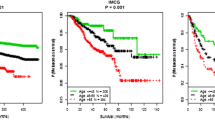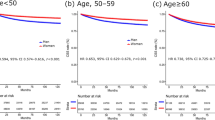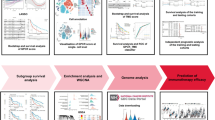Abstract
Background
Cancer diagnoses and deaths among the elderly (65 +) are expected to increase significantly over the next decade. Immune checkpoint inhibitors specifically target ICI genes and enhance immune system function. However, poor outcomes may be associated with aging.
Methods
We downloaded the Genomic Data Commons from the Cancer Genome Atlas (TCGA) and collected gene expression data from malignant melanoma (MM) tissues, the third level as the primary site. The CKTTD ICI genes database were applied and validated using the GEO database and lab experiments.
Results
In 414 patients, 13 ICI genes were obtained as risk gene signature by univariate and multivariate Cox hazard models and were associated with poor survival in the older group. At 1, 3, and 5 years (79%, 76%, and 76%, respectively), we investigate TNFRFS4 gene and age prediction using novel nomogram-associated aging (HR = 1.79, P 0.001, CI = 1.32–2.45) with higher sensitivity testing.TNFRSF4 gene expression was significantly high in younger (15 years interval) MM patients (P < 0.001). By correlation analysis, a significant negative association was determined (P < 0.001). The validation of gene correlation from GEO (GSE59455) and (GSE22153) was obtained as external validation. We tested the TNFRSF4 protein levels by IHC in 14 melanoma tissue samples. TNFRSF4 expression was observed to be lower expressed in the older of melanoma tissues, and higher in the younger age group (P = 0.02). Besides the connectivity of ICI gene proteins, the biological processes of cell aging, aging, and the immune system were found to be highly related.
Conclusions
Along with the risk score evaluation, the ICI gene (TNFRSF4) was identified as a tumor suppressor gene related to inequalities in age survival and associated with immune cell infiltrations. The aging responses of melanoma patients and related gene expression need further investigation in order to identify potential therapeutic targets.
Similar content being viewed by others
Introduction
It is critical to have a high degree of tolerance to chemotherapy treatments. As a result of the development of breakthrough immunomodulatory antibody therapies that depend on the patient's immune system to manage malignancies in recent years, the issue of immunosenescence has risen to prominence on the medical agenda, prompting a flurry of new research and discussion [1,2,3]. The discovery of immune checkpoint inhibitors, which target the programmed cell death 1(PD-1), programmed cell death ligand (PDL1), and cytotoxic T lymphocyte antigen 4 pathways, has resulted in the development of new cancer therapies [4, 5]. This method, which involves targeting the immune system, has shown remarkable efficacy in the treatment of many cancers, and several medications have been licensed by health authorities and are now in clinical trials [11, 18]. The majority of the results of aged and MM patients, whether in a localized or remote location and in the ICI and non-ICI eras, are still controversial [19, 20]. However, almost the older MM patients exhibit more adverse and poorer prognosis than younger patients [21,22,23,24,25]. Overall, our cohort study reported that older people experience a worse prognosis than younger patients. We reported a significant novel, unique risk score for genes that was applied from the recent ICI genes database, CKTTD. This score will help with prediction and risk identification for MM patients. The aging effect was clear in this cohort in general and was significantly worse for the adults than for the non-adults. Further, we looked at the risk genes, correlated them with aging, and found that oncosupressor genes that are less common in older MM patients than in younger MM patients.
In addition to CSF1, TLR8, TLR4, and NOX4, TNFRSF4 was the most significantly associated and adversely correlated with age in both TCGA and GEO with aging. This risk score signature may play an essential role in the future as targeted ICI genes increase its expression for adult people in the immunotherapy era. The literature is fairly reported for this new gene about TNFRSF4 and its clinical efficacy and /or associated immune cells. In leukemic stem cells, stimulation of TNFRSF4-signaling did not deplete Tregs but impaired the potential of Tregs to protect LSCs from CD8 + CTL-mediated death. In the bone marrow of newly diagnosed chronic myeloid leukemia patients, TNFRSF4 mRNA levels were dramatically raised and linked with the expression of the Treg-restricted transcription factor FOXP3 [26]. Survival and TNFRSF4 expression with different immune cells were investigated in our study. The survival prediction of TNFRSF4 and associated age was significantly presented as a novel prognostic model. In the experiments, we tested TNFRSF4proten expression in 14 patients and investigated the score of the expression, which revealed a significant increase in the younger group of patients (< 65) compared to the older group. The patients' data, on the other hand, were small, but the significant difference was clear. Finally, our research identifies specific genes and gene pathways that may be responsible for the aging-related decrease in life expectancy. Also, we think about what might be behind these changes and what might be interesting research subjects for future studies on older people.
It is necessary to consider the limitations of this investigation. Firstly, owing to the study's retrospective character, it was difficult to rule out confounding variables that may have influenced the patients' prognosis in the future. Secondly, we only selected target data from TCGA and GEO public databases through biological algorithm approaches. Thirdly, though the experimental work validation was reported, further investigation needed to be done by different methods. Moreover, it is relatively weak to consider only mRNA expression and protein expression because many more complicated mechanisms contribute to MM. Finally, further functional research is needed to find out how prognostic genes in MM work together and how they affect both prognosis and treatment.
In summary, this study aimed to determine the predictive value of a novel ICI gene-related risk score derived from a new ICI gene list in melanoma patients. Additionally, we identified a novel ICI gene (TNFRSF4), a tumor suppressor gene associated with age-related survival inequalities related to immune cell infiltration, which may be related to the development of aggressive behavior and carcinogenesis in adult patients. To identify potential therapeutic targets, extensive research and large cohort data are required to understand how the gene's products function as well as how melanoma patients react as they get older.
Availability of data and materials
The datasets generated and/or analysed during the current study are available in the GDC portal repository, [https://portal.gdc.cancer.gov/].
References
Varadé J, Magadán S, González-Fernández Á. Human immunology and immunotherapy: main achievements and challenges. Cell Mol Immunol. 2021;18(14):805–28.
Aiello A, Farzaneh F, Candore G, Caruso C, Davinelli S, Gambino CM, Ligotti ME, Zareian N, Accardi G. Immunosenescence and its hallmarks: How to oppose aging strategically? A review of potential options for therapeutic intervention. Front Immunol. 2019;10:2247.
Pawelec G. Does patient age influence anti-cancer immunity? Semin Immunopathol. 2019;41(1):125–31.
Wong SK, Beckermann KE, Johnson DB, Das S. Combining anti-cytotoxic T-lymphocyte antigen 4 (CTLA-4) and -programmed cell death protein 1 (PD-1) agents for cancer immunotherapy. Expert Opin Biol Ther. 2021;21(12):1623–34.
Han Y, Liu D, Li L. PD-1/PD-L1 pathway: current researches in cancer. Am J Cancer Res. 2020;10(3):727–42.
Safi M, Ahmed H, Al-Azab M, **a Y-L, Shan X, Al-Radhi M, Al-Danakh A, Shopit A, Liu J. PD-1/PDL-1 inhibitors and cardiotoxicity; molecular, etiological and management outlines. J Adv Res. 2021;29:45–54.
Daste A, Domblides C, Gross-Goupil M, Chakiba C, Quivy A, Cochin V, de Mones E, Larmonier N, Soubeyran P, Ravaud A. Immune checkpoint inhibitors and elderly people: a review. Eur J Cancer. 2017;82:155–66.
Hong H, Wang Q, Li J, Liu H, Meng X, Zhang H. Aging, Cancer and Immunity. J Cancer. 2019;10(13):3021–7.
Kanesvaran R, Cordoba R, Maggiore R. Immunotherapy in older adults with advanced cancers: implications for clinical decision-making and future research. Am Soc Clin Oncol Educ Book. 2018;38:400–14.
Crooke SN, Ovsyannikova IG, Poland GA, Kennedy RB. Immunosenescence and human vaccine immune responses. Immun Ageing. 2019;16(1):25.
Zhang Y, Yao Y, Chen P, Liu Y, Zhang H, Liu H, LiuY, Xu H, Tian X, Wang Z, et al. Checkpoint therapeutic target database (CKTTD): the first comprehensive database for checkpoint targets and their modulators in cancer immunotherapy. J Immunother Cancer. 2020;8(2):e001247.
Kanehisa M, Goto S. KEGG: Kyoto Encyclopedia of Genes and Genomes. Nucleic Acids Res. 2000;28(1):27–30.
Kanehisa M. Toward understanding the origin and evolution of cellular organisms. Protein Sci. 2019;28(11):1947–51.
Kanehisa M, Furumichi M, Sato Y, Ishiguro-Watanabe M, Tanabe M. KEGG: integrating viruses and cellular organisms. Nucleic Acids Res. 2021;49(D1):D545–51.
Raudvere U, Kolberg L, Kuzmin I, Arak T, Adler P, Peterson H, Vilo J. g: Profiler: a web server for functional enrichment analysis and conversions of gene lists (2019 update). Nucleic Acids Res. 2019;47(W1):W191–8.
PPilleron S, Sarfati D, Janssen-Heijnen M, Vignat J, Ferlay J, Bray F, Soerjomataram I: Global cancer incidence in older adults, 2012 and 2035: A population-based study. Int J Cancer 2019;144(1):49–58.
Siegel RL, Miller KD, Jemal A. Cancer statistics, 2016. CA Cancer J Clin. 2016;66(1):7–30.
Zhang W, Zeng B, Lin H, Guan W, Mo J, Wu S, Wei Y, Zhang Q, Yu D, Li W, et al. CanImmunother: a manually curated database for identification of cancer immunotherapies associating with biomarkers, targets, and clinical effects. Oncoimmunology. 2021;10(1):1944553.
van Holstein Y, Kapiteijn E, Bastiaannet E, van den Bos F, Portielje J, de Glas NA. Efficacy and Adverse Events of Immunotherapy with Checkpoint Inhibitors in Older Patients with Cancer. Drugs Aging. 2019;36(10):927–38.
Cavanaugh-Hussey MW, Mu EW, Kang S, Balch CM, Wang T. Older age is associated with a higher incidence of melanoma death but a lower incidence of sentinel lymph node metastasis in the SEER databases (2003–2011). Ann Surg Oncol. 2015;22(7):2120–6.
Banerjee M, Lao CD, Wancata LM, Muenz DG, Haymart MR, Wong SL. Implications of age and conditional survival estimates for patients with melanoma. Melanoma Res. 2016;26(1):77–82.
O’Neill CH, Scoggins CR. Melanoma. J Surg Oncol. 2019;120(5):873–81.
Safi M, Al-Azab M, ** C, Trapani D, Baldi S, Adlat S, Wang A, Ahmad B, Al-Madani H, Shan X, Liu J. Age-Based Disparities in Metastatic Melanoma Patients Treated in the Immune Checkpoint Inhibitors (ICI) Versus Non-ICI Era: A Population-Based Study. Front Immunol. 2021;16(12).
Tas F, Erturk K. Patient age and cutaneous malignant melanoma: Elderly patients are likely to have more aggressive histological features and poorer survival. Mol Clin Oncol. 2017;7(6):1083–8.
Tsai S, Balch C, Lange J. Epidemiology and treatment of melanoma in elderly patients. Nat Rev Clin Oncol. 2010;7(3):148–52.
Hinterbrandner M, Rubino V, Stoll C, Forster S, Schnüriger N, Radpour R, Baerlocher GM, Ochsenbein AF, Riether C. Tnfrsf4-expressing regulatory T cells promote immune escape of chronic myeloid leukemia stem cells. JCI Insight. 2021;6(23).
Acknowledgements
None
Funding
This research was funded by the National Natural Science Foundation of China, Grant/Award Numbers:82172793.
Author information
Authors and Affiliations
Contributions
Safi, **,Al- danakh, and Jiwei; the conception and design of the study, acquisition of data, and analysis and interpretation of data (2) Safi, Qin, **, Al-radhi, Zhang,Wang, Adlat, and Jiwei,: drafting the article and revising it critically for important intellectual content, (3) Yi and Jiwei: Funding and correspondence. All authors approved the version to be submitted.
Corresponding authors
Ethics declarations
Ethics approval and consent to participate
Data are in an open tier which does not require access approval.
Consent for publication
Not applicable.
Competing interests
The authors have no competing interests to declare.
Additional information
Publisher’s Note
Springer Nature remains neutral with regard to jurisdictional claims in published maps and institutional affiliations.
Supplementary Information
Additional file 1:
Supplementary Table 1. Characteristics of malignant melanoma patients.
Additional file 2:
Supplementary Table 2. CKTTD ICI genes: GO and KEGG pathways.
Additional file 3:
Supplementary Table 3. Characteristics of affiliated hospital for malignant melanoma patients.
Additional file 4:
Supplementary Figure 1: univariate hazard model and multivariate hazard model regression A. 40 genes with a significant difference in low vs. high expression (P= <0.05) resulted B. The resulted 6 genes with low vs. high expression as risk score genes.
Additional file 5:
Supplementary Figure 2. A. overall survival rate for patients in the high-risk group was considerably lower than the rate for patients in the low-risk group in the risks core. (P = < 0.0001) B. the 6-gene signature's predictive potential was evaluated using a nomogram.
Additional file 6:
Supplementary Figure 3. The risk score genes as oncosuppressors (their high expression was related with greater survival than their low expression) with selected top 6 genes (P=< 0.05).
Additional file 7:
Supplementary Figure 4. ICI genes were illustrated and described in the context of the PPI network for CKTTD.
Additional file 8:
Supplementary Figure 5. Spearman's rho r value and statistical significance of the risk score and immune cells.
Rights and permissions
Open Access This article is licensed under a Creative Commons Attribution 4.0 International License, which permits use, sharing, adaptation, distribution and reproduction in any medium or format, as long as you give appropriate credit to the original author(s) and the source, provide a link to the Creative Commons licence, and indicate if changes were made. The images or other third party material in this article are included in the article's Creative Commons licence, unless indicated otherwise in a credit line to the material. If material is not included in the article's Creative Commons licence and your intended use is not permitted by statutory regulation or exceeds the permitted use, you will need to obtain permission directly from the copyright holder. To view a copy of this licence, visit http://creativecommons.org/licenses/by/4.0/. The Creative Commons Public Domain Dedication waiver (http://creativecommons.org/publicdomain/zero/1.0/) applies to the data made available in this article, unless otherwise stated in a credit line to the data.
About this article
Cite this article
Safi, M., **, C., Aldanakh, A. et al. Immune checkpoint inhibitor (ICI) genes and aging in malignant melanoma patients: a clinicogenomic TCGA study. BMC Cancer 22, 978 (2022). https://doi.org/10.1186/s12885-022-09860-2
Received:
Accepted:
Published:
DOI: https://doi.org/10.1186/s12885-022-09860-2




